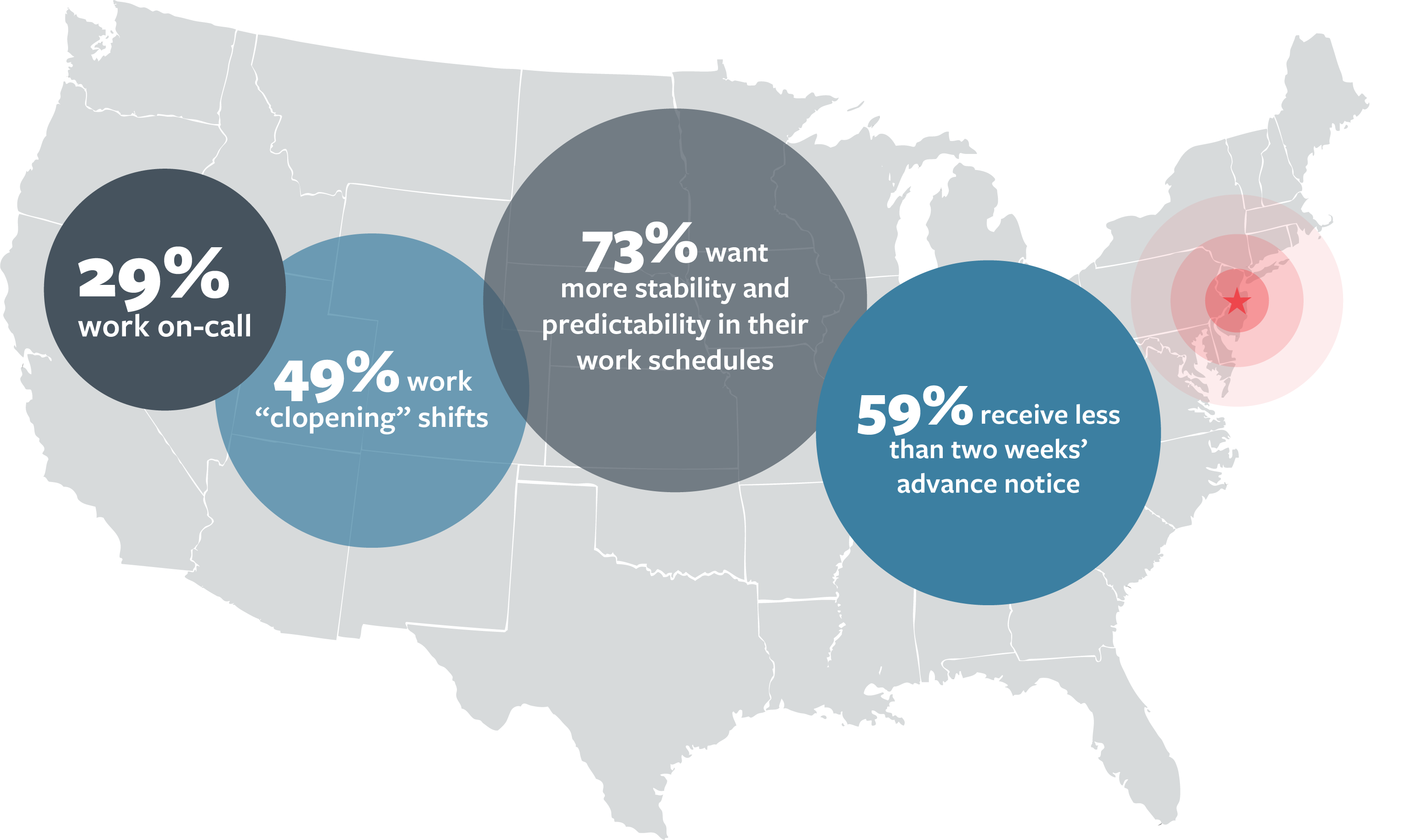Service sector jobs in the United States are characterized by low pay, few fringe benefits, and limited employee control over scheduled work days and times.1 Many service sector employers across the country rely on just-in-time and on-call scheduling practices designed to minimize labor costs by closely aligning staffing with consumer demand.2 These practices can introduce significant instability into the lives of workers and their families.3
This research brief is part of a series designed to advance our understanding of working conditions in the service sector—in particular, schedule instability and unpredictability—in cities and states across the country. Since 2016, The Shift Project has collected survey data from workers employed at large chain retailers and food-service establishments.4 We ask respondents about their work schedules, household economic security, health, and wellbeing, targeting employees at large firms that are the focus of recent state and local labor regulation efforts. Our data permit an unprecedented view of labor conditions in the service sector and provide unparalleled insight into the work and family lives of low-wage workers.
Over 500,000 people are employed in the retail and food-service sectors in the state of New Jersey.5 This brief describes the experiences reported by 1,996 of these workers in order to capture working conditions in New Jersey’s service sector.
Insufficient Wages and Work Hours
During the period described in our data (March 2017 to June 2019), the minimum wage in New Jersey was $8.85 per hour. In our study, the median reported wage was $12.00 per hour, with most workers (66%) reporting wages that still fall below the estimated living wage for a single adult with no children ($13.92).6
It is important to note that the estimated living wage is based on year-round full-time employment, and that only a minority of the New Jersey workers in our study report full-time work. In contrast, half (51%) of workers report working fewer than 35 hours per week, and 69% report working fewer than 40 hours per week.
What do workers want? Although some workers may prefer a part-time work schedule, the majority of workers we surveyed reported a desire for more work hours than they typically receive. Over half of New Jersey workers—57% overall, and 63% among those working fewer than 35 hours per week—reported that they would like to work more hours. A third (32%) of those in our study can be characterized as “involuntary part-time” workers—that is, people who work fewer than 35 hours per week at their primary job and who would like more hours. If we expand our measure of “part-time,” we see that 43% of workers typically work fewer than 40 hours per week at their primary job and would like more hours.
Unstable and Unpredictable Work Schedules
In addition to widespread part-time scheduling that could restrict the number of hours and total income available to workers, we also find that New Jersey workers experience instability and unpredictability in their work schedules.
A majority of the workers in our sample report work schedules that are irregular or non-standard: 28% report “variable” schedules, 21% report “rotating” schedules, and another 18% report regularly working night or evening shifts. Only a quarter of service sector workers report a regular daytime work schedule.
We also asked workers whether they had experienced certain workforce management practices associated with just-in-time scheduling in the past month. Twenty-nine percent of workers reported working at least one “on-call” work shift in the prior month, meaning that they kept their schedule open and available for work but may or may not actually have been called in to work the shift. One out of five workers reported having at least one shift cancellation in the past month. Half of workers reported working consecutive closing-then-opening shifts at least once in the prior month, referred to as “clopening.”
New Jersey workers also experience a great deal of variation in the total number of hours worked each week. When asked about their work schedule over the past month, the average worker reported a difference of 13 hours between the week they worked the most hours and the week they worked the fewest hours. In percentage terms, that is a 37% gap between the hours worked in the week with the most hours and that with the fewest. Given our focus on workers who are paid hourly, we know these variations in hours lead to volatility in earnings—indeed, over half of workers report that their income varies from week to week.
In addition to the common experience of schedule instability, many workers experience unpredictability and receive limited advance notice of their work schedules. Fewer than half (41%) of the workers in our sample receive more than 2 weeks’ advance notice of their work schedules. Another 26% receive between 1 and 2 weeks’ notice. The remaining 33% of workers receive less than 1 week’s advance notice; of those, half receive no more than 2 days’ notice. Seventy percent of workers reported that they recently experienced a change in the timing or length of a scheduled shift (for example, they were asked to come in early or late, or to leave early or to stay later than the hours they were originally scheduled for). Of those who experienced a change in the timing of their shift, the vast majority (81%) received less than 2 days’ notice of the change, and 67% received less than 24 hours’ notice.
These measures show that many New Jersey service sector workers experience unstable and unpredictable work schedules. We also find that these workers often do not have control over their schedules. Nearly half of workers have no input when it comes to setting their work schedules, 29% have some input, and only 19% of workers have a large degree of control over their scheduled work days and times.
Compounding all of these dimensions of scheduling instability, most workers reported that even in their personal time, they have to keep their schedule open and available for work. Two-thirds of workers reported that they keep their schedule open and make themselves available even when they are not scheduled to work. This has implications for their ability to balance work and family responsibilities, to combine work with schooling or other pursuits, and to achieve a work-life balance.
What do workers want? When asked their preference, three-quarters of workers said that they “would like to have a more stable and predictable work schedule.” This share was even higher among New Jersey workers who reported a variable schedule (82% of those workers) or workers who reported working at least one on-call shift in the prior month (77% of those workers).
Challenges Reported by New Jersey Workers
Given the constellation of unstable and unpredictable scheduling practices experienced by New Jersey service sector workers in our sample, it is not surprising that many of these workers report that their work schedule interferes with their family needs and caregiving responsibilities. Nearly half of workers report that their work schedule does not provide enough flexibility for them to handle family needs. Nearly a third of workers say that their work schedule is a chronic source of extra stress for their family, and 65% say that their work schedule sometimes, often, or always causes extra stress. Forty percent say that their work schedule always or often makes it hard to meet their caregiving responsibilities, and an even larger share (69%) sometimes, often, or always experience conflicts between work and their caregiving responsibilities.
The variation in hours coupled with low wages and, for some workers, insubstantial hours, leads to income volatility and could impact workers’ financial security as well. In our sample, 68% of workers reported that, in a typical month, they find it very difficult or somewhat difficult to cover their expenses and pay all their bills. When we asked workers whether they could come up with $400 if an unexpected need arose within the next month, 40% doubted that they could come up with the money.
Irregular Scheduling and Student Workers
We document the prevalence of schedule instability and unpredictability for low-wage workers in New Jersey, but these conditions may pose specific challenges for the 38% of workers who are enrolled in school. Most of these students (56%) are high school graduates who are working on furthering their education. Comparing student workers in our New Jersey sample to workers who are not enrolled in school, we find that:
- Student workers have more variation in number of work hours. Student workers report a gap of 46% between the week with the most hours and the week with the least hours in the previous month, compared to 31% of non-students. It could be assumed that this variability is preferable for workers who are enrolled in school, however, a nearly equal proportion of students and non-students (58% compared to 57%) said they would prefer more hours.
- Student workers have higher exposure to just-in-time scheduling practices. Student workers report higher rates of on-call shifts (35% compared to 26% of non-students), changes to the timing or length of shifts (76% v 66%), shift cancellation (24% v. 18%) and “clopenings” (52% v. 46%).
- Students also want predictability. Student workers reported a similar desire for more predictability in their schedules (71%) compared to non-student workers in New Jersey (73%).
By these measures, student workers report similar or worse schedule instability than non-students, and it is likely that this instability impacts their education. Nearly half (46%) of student workers reported that their work schedule makes it difficult for them to attend classes, study, and complete school work.
Intergenerational Consequences of Work Scheduling
Over a quarter of the New Jersey retail and food-service workers in our sample were parents living with children aged 0 to 14. These workers reported similar exposure to unstable and unpredictable schedules as workers without young children. For instance, 26% of parents had at least one cancelled shift in the previous month (against 18%), 33% had an on-call shift (compared to 28%), and 48% worked a “clopening” shift (compared to 49%).
For working parents, like those in our New Jersey study, schedule instability and unpredictability can spill over and have negative consequences for their children.7 Children thrive in environments of security, consistency, and support, with stable and high-quality child care arrangements, but just-in-time scheduling makes arranging this type of care very difficult.8 We have examined the consequences of these scheduling practices for working parents in our national data, focusing on the parents of young children aged 0 to 4 (early years that are crucial to healthy child development). We find that parents’ exposure to on-call work and last-minute shift changes are associated with a reliance on informal care arrangements involving multiple, rotating caregivers (including siblings who might be young children themselves), and rarely involving high-quality center-based childcare.9
Further, unstable and unpredictable schedules may reduce child wellbeing by undermining household economic security, upsetting family routines, and introducing strain and stress into everyday parent-child interactions that would ideally be warm and supportive. We observe that children whose parents’ experience schedule instability show more “internalizing” or sad behaviors (feeling worthless, anxious, guilty, self-conscious, unhappy, or worried) and more “externalizing” or mad behaviors (arguing, destroying things, being disobedient, stubborn, having temper tantrums, or making threats).10
The Relationship Between Work Schedules and Worker Health and Hardship
Exposure to unstable and unpredictable schedules may also negatively affect workers’ health and wellbeing. For example, short notice and last-minute schedule changes may lead to economic instability for workers and may also increase work-life conflict, while lack of certainty about one’s schedule may be an added source of stress.
To examine the impact of just-in-time scheduling on worker health, we compare the reported health and wellbeing of workers with the most stable and predictable schedules to those with the least stable and predictable schedules.11 We find that:
- Workers with unpredictable work schedules are much more likely to report having experienced hunger hardship in the past year. Our survey asked all workers, “In the past 12 months, were you ever hungry, but didn’t eat because you couldn’t afford enough food?” Forty-three percent of New Jersey workers with unpredictable schedules experienced hunger in the past year, compared to 22% of workers with predictable schedules.
- Workers with unpredictable work schedules report worse sleep quality. Seventy percent of New Jersey workers with unpredictable schedules report poor or only fair sleep quality, compared to 57% of workers with predictable work schedules.
- Workers with unpredictable work schedules are less happy. Thirty-nine percent of New Jersey workers with the most unpredictable schedules report being unhappy overall, compared to 26% of workers with predictable work schedules.
- Workers with unpredictable work schedules are significantly more distressed. We asked workers how often they felt each of six types of distress in the past month (sadness, nervousness, restlessness, hopelessness, that everything was an effort, and that difficulties were piling up high). Overall, workers with unpredictable schedules scored 45% higher on the distress scale than those with predictable schedules.12
Discussion
The Shift Project’s survey of service sector workers provides a window into the experiences of workers employed at large retail and food establishments across the nation. This brief describes the experiences of workers in New Jersey, with specific attention to the experiences of student workers, the intergenerational impact of parents’ work schedules, and associations between just-in-time scheduling and worker health.
The portrait of New Jersey service sector workers reveals that unstable and unpredictable schedules are commonplace. As we have seen nationally, the retail and food sectors in New Jersey are characterized by low pay, insufficient work hours, and a lack of control over scheduled work hours. With the Shift data, we can also see how workers contend with schedules that are announced with little notice and that are often changed at the last minute. By hearing directly from workers, we can learn not only about their experiences, but about their preferences. The majority of workers express a desire for more work hours and more predictability in their work schedules.
Scheduling practices are beginning to change, as some localities have passed labor laws that regulate work schedules. The state of Oregon, New York City, Seattle, Philadelphia, Chicago, San Francisco, and Emeryville (CA) have all passed legislation or implemented regulations requiring a certain amount of advance notice of work schedules (usually two weeks) and stipulating that workers be compensated by employers when their shifts are changed on shorter notice. Many of these new labor regulations also include an “access to hours” provision, requiring that employers offer more hours to their part-time workers before hiring additional part-time employees.
New Jersey has been at the policy forefront by legislating paid parental leave and earned sick leave. However, there is currently no law in the state of New Jersey that explicitly regulates scheduling practices for hourly service sector workers. In this context, our data reveal that scheduling practices such as short advance notice and last-minute scheduling changes are a common experience for New Jersey workers. We document workers’ desire for more stable schedules, and find strong relationships between unstable schedules and undesirable outcomes such as hunger and poor sleep quality.
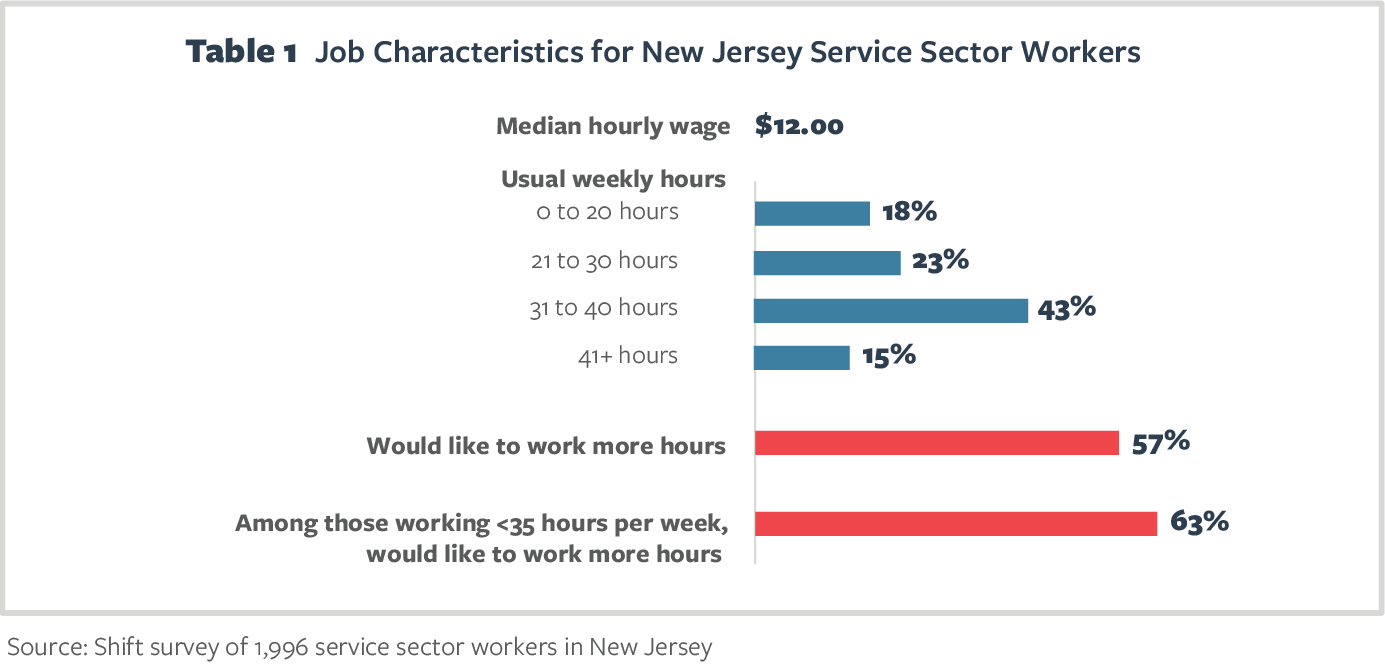
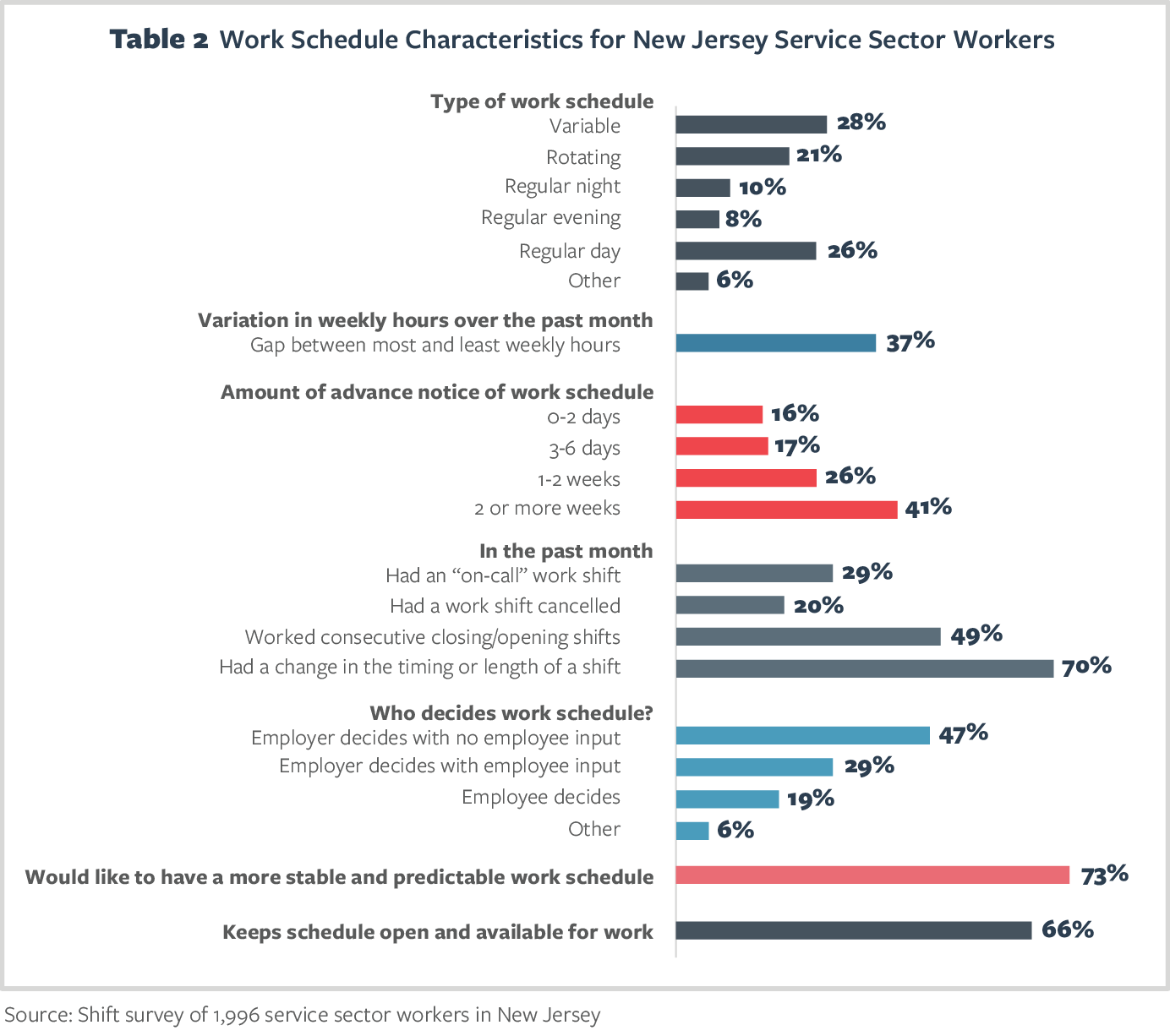
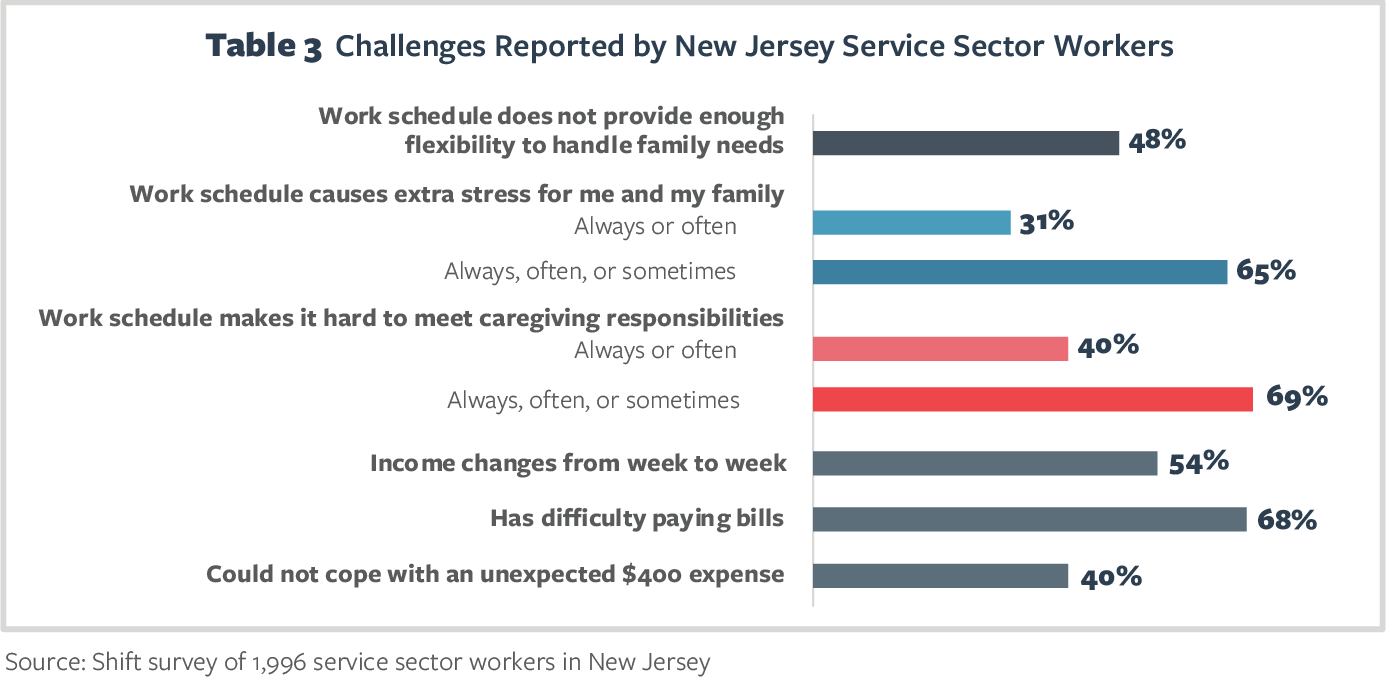
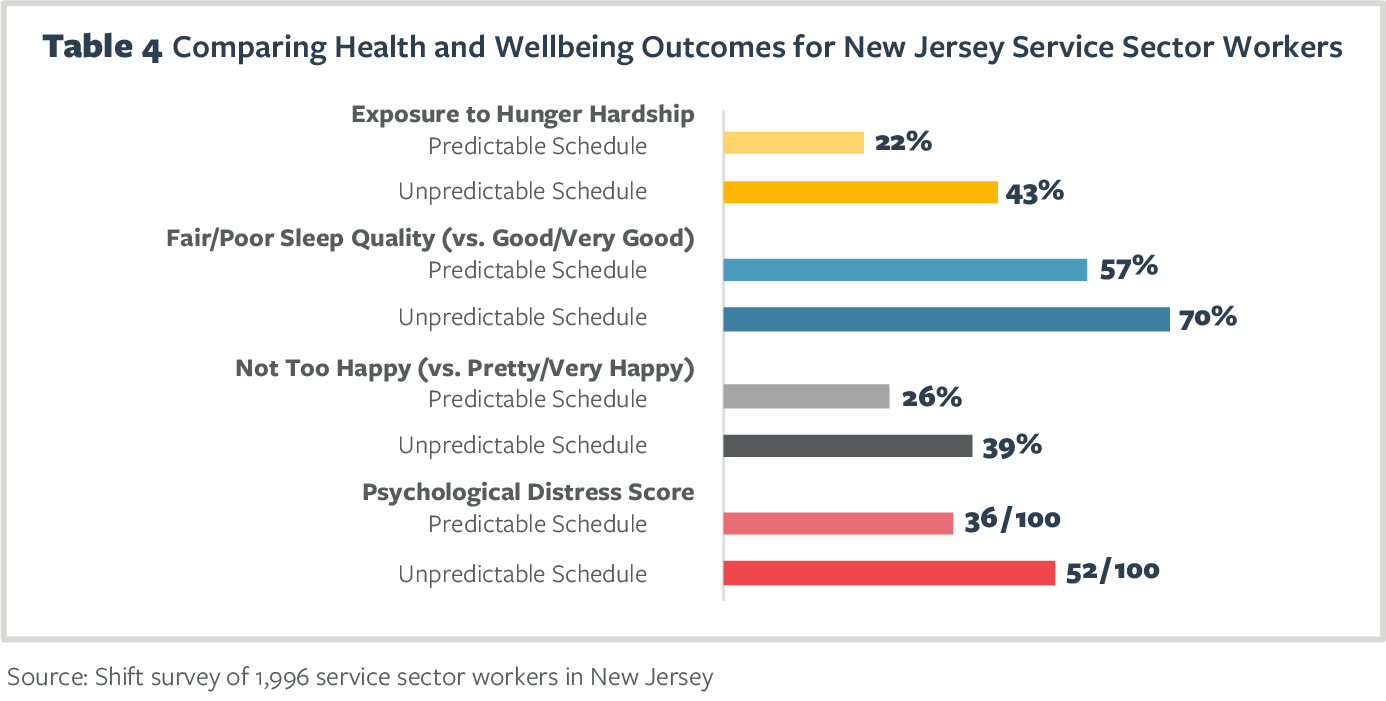
Endnotes
-
- Lambert, S. J. 2008. “Passing the Buck: Labor Flexibility Practices that Transfer Risk onto Hourly Workers.”
Human Relations
-
- 61(9): 1203-1227.
2 Golden, L. 2015. “Irregular Work Scheduling and Its Consequences.” Briefing Paper #394. Economic Policy Institute; Appelbaum, E., A. Bernhardt, and R. J. Murnane. (Eds.). 2003. Low-Wage America: How Employers are Reshaping Opportunity in the Workplace. New York: Russell Sage Foundation; Clawson, D., and N. Gerstel. 2015. Unequal Time: Gender, Class, and Family in Employment Schedules. New York: Russell Sage Foundation.
3 Lambert, S.J., P. Fugiel, and J. R. Henly. 2014. Precarious Work Schedules among Early-Career Employees in the US: A National Snapshot. University of Chicago; Schneider, D. and K. Harknett. 2019. “Consequences of Routine Work-Schedule Instability for Worker Health and Well-Being.” American Sociological Review 84(1): 82-114.
4 Further details about our data collection and methodology are presented in an Appendix at the end of the Research Brief.
5 https://www.bls.gov/oes/current/oes_nj.htm
6 The Living Wage Calculator, created by Dr. Amy K. Glasmeier, Professor of Economic Geography and Regional Planning at MIT.
7 Heckman, J. 2006. “Skill Formation and the Economics of Investing in Disadvantaged Children.” Science 312: 1900-1902.
8 Sandstrom, H., & Huerta, S. 2013. The Negative Effects of Instability on Child Development: A Research Synthesis. Washington, DC: Urban Institute; Burchinal, M., Magnuson, K., Powell, D., & Hong, S. S. 2015. “Early Childcare and Education.” In R. M. Lerner, M. H. Bornstein, & T. Leventhal (Eds.), Handbook of Child Psychology and Developmental Science: Ecological Settings and Processes. Hoboken: John Wiley & Sons, Inc.
9 Carrillo, D., K. Harknett, A. Logan, S. Luhr, and D. Schneider. 2017. “Instability of Work and Care: How Work Schedules Shape Child-Care Arrangements for Parents Working in the Service Sector.” Social Service Review 91(3): 422-455; Harknett, K., D. Schneider, and S. Luhr. 2019. “Who Cares if Parents have Unpredictable Work Schedules?: The Association between Just-in-Time Work Schedules and Child Care Arrangements.” Washington Center for Equitable Growth Working Paper. https://equitablegrowth.org/working-papers/who-cares-if-parents-have-unpredictable-work-schedules-the-association-between-just-in-time-work-schedules-and-child-care-arrangements/
10 D. Schneider anad K. Harknett. 2019. “Parental Exposure to Routine Work Schedule Uncertainty and Child Behavior.” Washington Center for Equitable Growth Working Paper. https://equitablegrowth.org/working-papers/parental-exposure-to-routine-work-schedule-uncertainty-and-child-behavior/
11 We define workers with the “most stable and predictable schedules” as those who typically receive at least 2 weeks’ advance notice of their schedules; did not work on-call, have a shift cancelled, or work a “clopening” shift in the last month; and did not recently experience a change to the timing or length of a shift. Workers with the “least stable and predictable schedules” are those who typically receive less than 2 weeks’ advance notice; worked at least one on-call shift, experienced at least one cancelled shift, and worked at least one “clopening” shift in the past month; and recently experienced a change to the timing or length of a shift.
12 These findings are based on “regression analysis,” a widely-used analytic technique in the social sciences, which is designed to isolate the effects of unpredictable work schedules while “holding constant” other influences. In this case, the reported relationships between having an unpredictable work schedule and health and hardship outcomes are “net of” statistical controls for worker age, gender, children in household, educational attainment, school enrollment, marital status, household income, hourly wage, job tenure, usual hours, and managerial status, as well as year and month fixed-effects. However, we also note that these are not causal estimates. These results are based on the same regression models that we use to estimate the association between work schedules and worker health and wellbeing for a national survey of workers. These methods are described in detail in Schneider, D. and K. Harknett. 2019. “Consequences of Routine Work-Schedule Instability for Worker Health and Well-Being.” American Sociological Review 84(1): 82-114.
Acknowledgements
Support for this brief was provided in part by the Robert Wood Johnson Foundation (Award No. 74528 and Award No. 45264). The views expressed here do not necessarily reflect the views of the Foundation. Research reported in this publication was also supported by the Eunice Kennedy Shriver National Institute of Child Health & Human Development of the National Institutes of Health (Award No. R21HD091578). The content is solely the responsibility of the authors and does not necessarily represent the official views of the National Institutes of Health. We also gratefully acknowledge support from the W.T. Grant Foundation, the Washington Center for Equitable Growth, and the Institute for Research on Labor and Employment.The authors gratefully acknowledge the work of Connor Williams, Data Analyst for The Shift Project, in preparing the data for this research brief.
